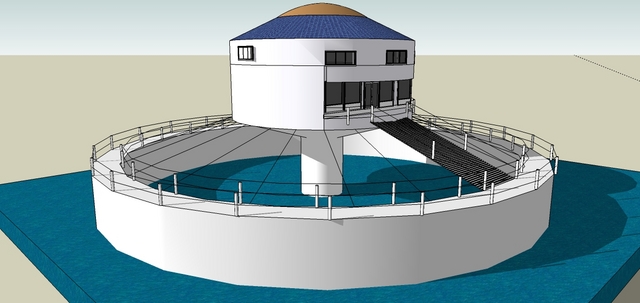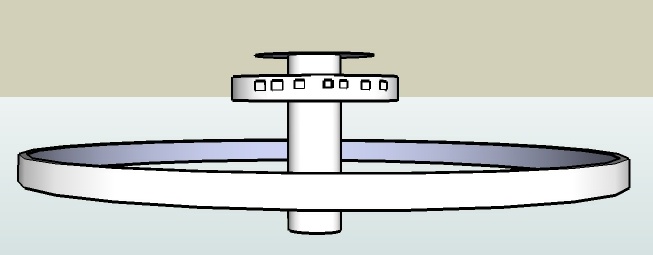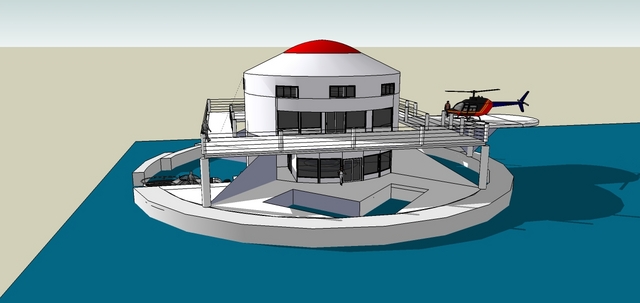Difference between revisions of "User:Vincecate/Tension circle house"
(→Videos of 9-foot model tests) |
(→Video of 5 food PVC model) |
||
| Line 56: | Line 56: | ||
** Very shallow draft. | ** Very shallow draft. | ||
| − | ==Video of 5 | + | ==Video of 5-foot PVC model== |
<youtube v="mlsTXb_qyRA" /> | <youtube v="mlsTXb_qyRA" /> | ||
Revision as of 05:13, 17 July 2008
Contents
Description
The idea is to use a tension circle to hold a house up. Having the flotation very wide makes it stable. The house does not need to be so far above the waves because it is floating up with the large waves. Does not need to go deep into the water because stability comes from the great width.
Detail
- Material issues - concrete, foam inside wall. Since it does not go far below the water foam and concrete should be ok. With foam cracks in the concrete will not be fatal.
- Tension members could be plastic rope or steel cable (note they are not in drawing above)
- Inside of main column can be used for storage or general living space
- Would use kite and sea anchor for movement on migration
Energy storage
If the outer circle were made from a large pipe, maybe 36-inch sched-40 stainless steel, it could be be used for compressed air energy storage. This would store plenty of energy for the average family. Could even be used to power motors for maneuvering in a port. But for extra safety it is nice to have the outer ring filled with foam. Might have the column below the house be a big pipe that was used for compressed air.
Requirements Analysis
- Safety
- It is very wide compared to boats and so should be very stable
- Wall is filled with foam so essentially unsinkable
- No active ballast controls so no chance of that going wrong
- Comfort
- Should have a gentle motion on normal days but significant response to large waves.
- Cost
- This should be one of the cheapest designs. It's very simple. Although it is as wide as a large cruise ship, most of the area is just cables over open space.
- Pretty
- Looks nice. Could cover over wires and put down grass so you had a real floating island. Could be very pretty.
- Modular
- Can make individual family sized units. Could have cable under a line of these so they floated together if you connected a sea anchor at one end and a large kite at the other.
- Cargo
- Since it floats up and down with waves like a boat, should be reasonable to dock a boat next to it. Probably have a small dock mounted on the wall so it could float up and down a bit relative to the wall. Need a walkway from house to where boat will dock.
- Free Floating
- Yes, could anchor also.
- Scalable
- Scales up or down in size (height, diameter).
- Standards
- Mobile
- Could lift it up and put in on a barge for long distance transport. Would need something under the wall that was the height that the center column goes below the wall (maybe a couple containers stacked up). Could also use a floating dry dock for transport. For short distance slow travel it could be moved but use a lot of energy due to high drag shape.
- Draft
- Very shallow draft.
Video of 5-foot PVC model
<youtube v="mlsTXb_qyRA" />
Videos of 9-foot model tests
<youtube v="oLKEpt2wAS0" /> Initial launch.
<youtube v="HxUszZyNgXs" /> Compare the stability of the central PVC pipe in the model (where a house would be in the full sized version) to the stability of the larger and far more expensive real boat in the background.
<youtube v="omoaB5wLz6Y" />
If the real full scale ring was 144 feet across, it would be 16 times bigger than this model. The rules for scaling models state that time is faster in the model by the square-root of the scaling factor. So I have slowed down this video by a factor of 4 to see the time to move back and forth when a big wave comes. The 1 foot wall becomes a 16 foot wall, with 8 feet above water and 8 feet below in the full scale prototype.


